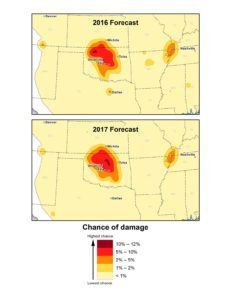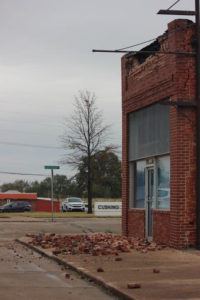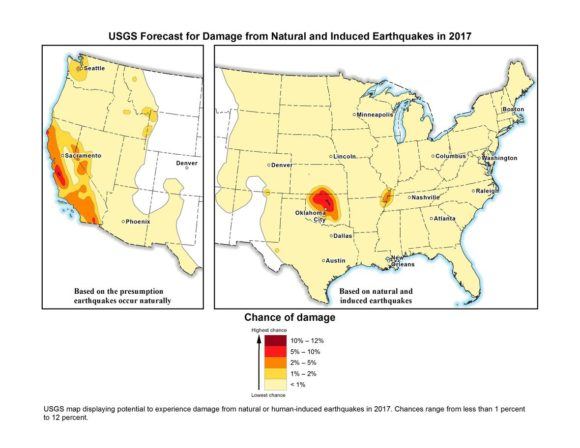Oklahoma experienced fewer earthquakes last year compared with 2015 and a recent study of human-induced earthquakes predicts another year of reduced seismicity for the state in 2017.
The U.S. Geological Survey warns, however, that that Oklahoma and southern Kansas, along with the Colorado/New Mexico area known as the Raton Basin, remain the areas with the highest risk of induced seismicity in the United States.
A report released by the USGS in early March, “New USGS Maps Identify Potential Ground-Shaking Hazards in 2017,” shows a significant chance for damaging levels of ground motion in those regions in 2017.
Parts of Texas and northern Arkansas also have an enhanced risk from induced seismicity in 2017, “but the levels are significantly lower in these regions than that forecasted for 2016. While earthquakes are still a concern, scientists did not observe significant activity in the past year, so the forecasted hazard is lower in 2017,” according to the USGS.
This is the second year the federal agency has mapped potential ground-shaking hazards from both human-induced and natural earthquakes in the central and eastern U.S., known as the CEUS. Previous USGS maps only identified hazards from natural earthquakes. The research was originally published in the journal, Seismological Research Letters.

The study reveals that while the New Madrid Seismic Zone in the Central U.S. has not experienced induced earthquake activity, it has seen a higher rate of natural temblors over the last three years. Therefore, the study shows a “slightly higher hazard potential compared to previous years in portions of Arkansas, Missouri, Illinois, Kentucky and Tennessee,” the USGS reported.
The USGS describes induced earthquakes as those “triggered by human activities, with wastewater disposal being the primary cause …. Wastewater from oil and gas operations can be disposed of by injecting it into deep underground wells. Injected fluids cause pressure changes that can weaken a fault and therefore bring it closer to failure.”
Between 1980 and 2000, Oklahoma averaged two earthquakes per year that were greater than or equal to magnitude 2.7. That number rose significantly in 2014, when around 2,500 magnitude 2.7 and higher quakes were recorded. A peak was reached in 2015, with 4,000 such temblors, and the number dropped in 2016 to 2,500. However, 21 of the quakes that struck Oklahoma last year were greater than magnitude 4.0 and three were greater than magnitude 5.0.
The USGS asserted the decline in the number of earthquakes in Oklahoma could be due in part to the restrictions on wastewater injection volumes put in place by the Oklahoma Corporation Commission, which regulates oil and gas activities in the state.

One of the largest earthquakes recorded in Oklahoma occurred in November 2016 when a 5.0 magnitude temblor struck near Cushing. Around 45 to 50 homes were said to have been affected and AIR Worldwide reported that a 16-block area in downtown Cushing had to be cordoned off because of danger posed by unstable façades and broken glass.
Oklahoma’s strongest quake to date occurred approximately a month earlier on Sept. 3, 2016 — a 5.8 magnitude temblor near Pawnee.
The Cushing earthquake was of particular concern because the town about 50 miles northeast of Oklahoma City is home to one of the largest oil storage terminals in the world. No damage at the terminal site was reported, but federal, state and local safety officials have expressed concern over the potential threat to the oil storage facilities from the increase in seismic activity in the area.
Mark Petersen, chief of the USGS National Seismic Hazard Mapping Project, said the 2016 prediction for Oklahoma was “quite accurate in assessing hazardous areas” and that the possibility of significant damage in the state last year had been forecasted.
“However, the significantly decreased number of earthquakes in north Texas and Arkansas was not expected, and this was likely due to a decline in injection activity,” he said.
“There is specific concern in parts of the central U.S. since the forecasted hazard levels are higher than what is considered in current building codes, which only incorporate natural earthquakes,” Petersen said.
The uptake rate for earthquake insurance in Oklahoma is about 10 to 15 percent, according to the Oklahoma Insurance Department. While Insurance Commissioner John Doak would like to see more property owners choosing to purchase the coverage, either in the form of an endorsement or a stand-alone policy, he recognizes there are limitations to the effectiveness of the coverage for Oklahomans. That’s mainly because the damage costs incurred in relatively low magnitude earthquakes are often less than the deductible.
“The deductibles are high and not well suited to Oklahoma, which has a frequency problem, not severity,” Commissioner Doak told Insurance Journal last November. “Someone that has experienced 800 earthquakes with 3.0 magnitude and under has different issues than someone who has a 6.2 or 6.5 mag quake.”
Related:
- Property Damage Reported After 5.0 Mag Quake Hits Oklahoma near Cushing
- Will Rising Earthquake Risks in Oklahoma Shake Up the Insurance Market?
- Only 4 Out of 300 Claims Paid After Record Oklahoma Earthquake
- Oklahoma Agency to Limit More Disposal Wells After Oil Hub Earthquake
- EPA to Oklahoma Officials: Do More to Curb Earthquakes
- Insurers Limit Exposure as Quakes Increase in Oklahoma
Topics Catastrophe Trends USA Energy Oil Gas Pollution Oklahoma
Was this article valuable?
Here are more articles you may enjoy.



 Baldwin Group to Buy CAC Group for About $1B in Cash and Stock
Baldwin Group to Buy CAC Group for About $1B in Cash and Stock  One of Highest Property Claims Severity Recorded in Q3 on Low Volume, Says Verisk
One of Highest Property Claims Severity Recorded in Q3 on Low Volume, Says Verisk  Chubb, The Hartford, Liberty and Travelers Team Up on Surety Tech Launch
Chubb, The Hartford, Liberty and Travelers Team Up on Surety Tech Launch  Acrisure CEO Greg Williams Makes $400M Commitment to Michigan State University
Acrisure CEO Greg Williams Makes $400M Commitment to Michigan State University 

